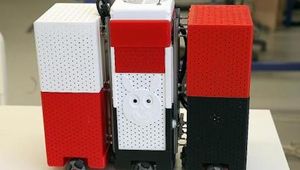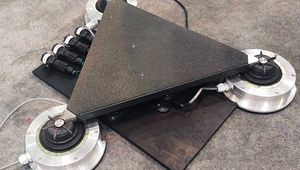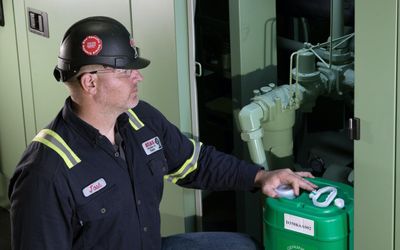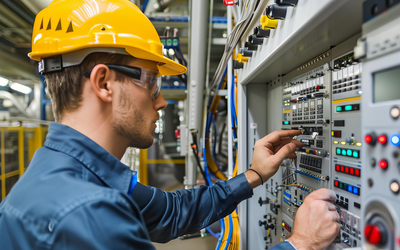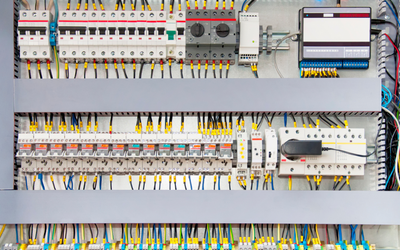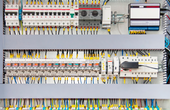Portenta Machine Control
Industrial-grade control unit, enabling real-time automation and IoT integration
General
| Product Type | Development Boards |
| Applications | Industrial Automation, IoT & Smart Systems, Embedded Systems |
| Key Features | Portenta H7, Arm Cortex M7 , M4 Processor, 16MB Flash, 8MB SDRAM, 24V DC |
Technical Specifications
| Processor | STM32H747XI Dual-Core Cortex-M7+M4 (Portenta H7) |
| Input | 8x Digital 24VDC, 2x Encoder Readings, 3x Analog, 3x Analog (4-20mA/0-10V/NTC 10K) |
| Output | 8x Digital 24VDC (up to 0.5A, short circuit protection), 4x Analog 0-10V |
| Other I/O | 12 Programmable Digital I/O (24V logic) |
| Memory | 16MB Flash, 8MB SDRAM |
| Communication | CAN-BUS, Serial RS232/422/485 (Programmable) |
| Connectivity | Ethernet, USB Programming Port, Wi-Fi, BLE |
| Power | 24V DC ± 20% |
Overview
The Arduino Portenta Machine Control is a powerful industrial control unit designed to bring advanced Industrial IoT capabilities to standalone machinery. Built around the Portenta H7 with a dual-core STM32H747XI Arm Cortex-M7+M4 processor, it delivers exceptional computing power for real-time control, predictive maintenance, and AI-driven applications. Designed for harsh industrial environments, it operates reliably in temperatures from -40°C to +85°C.
The module features eight digital inputs and outputs (24VDC), multiple analog inputs for sensors and probes, encoder support, and 12 programmable I/Os. With multiple connectivity options including Ethernet, USB, Wi-Fi, and BLE, the device also supports CAN-BUS and serial communication protocols (RS232/422/485). Programming is flexible via the Arduino framework or other embedded platforms. The Portenta Machine Control enables remote monitoring, cloud-based control, and rapid deployment through push-in terminals, making it an ideal solution for modernizing factory operations with smart, centralized automation.
Features of Portenta Machine Control
The Portenta Machine Control offers a robust industrial automation platform. Its rich feature set, including diverse I/O, powerful processing, and versatile communication, empowers advanced machine control and IoT integration. Let’s explore these features in detail:
Embedded Control and Processing Capabilities
The Portenta Machine Control is equipped with the STM32H747XI dual-core Cortex-M7+M4 processor (Portenta H7), delivering a powerful embedded platform for industrial applications. It supports industry-standard soft-PLC control and is compatible with the Arduino framework and other embedded development environments. The board includes 16MB of onboard Flash and 8MB of SDRAM for advanced applications such as predictive maintenance, real-time monitoring, and AI deployment at the edge. An integrated Real Time Clock (RTC) enables precise synchronization of processes, supporting the execution of deterministic control logic across a wide range of industrial use cases.
Flexible I/O Architecture and Sensor Compatibility
Designed to interface with a variety of sensors and actuators, the unit provides 8 digital 24VDC inputs, 2 encoder input channels, 3 analog temperature inputs (supporting PT100, PT1000, J, and K probes), and 3 analog signal inputs (4-20mA, 0-10V, NTC 10K). Outputs include 8 digital 24VDC (up to 0.5A with short circuit protection) and 4 analog outputs (0-10V, 20mA per channel). Additional 12 programmable digital I/Os with 24V logic support further customization. All I/O lines are protected by resettable fuses, and the device supports I2C for additional sensor interfacing.
Industrial-Grade Connectivity and Communication
The Portenta Machine Control integrates multiple connectivity options for real-time data exchange and remote control. Communication protocols include CAN-BUS and programmable serial interfaces (RS232, RS422, RS485). For networked applications, it offers Ethernet, USB, Wi-Fi, and Bluetooth Low Energy. These features enable integration with local HMIs or cloud platforms for equipment diagnostics, configuration, and usage monitoring. The platform supports modular adaptation, allowing operators to update systems with advanced interfaces like touchscreens, joysticks, and keyboards without replacing hardware.
Rugged Design and Deployment Versatility
Housed in a DIN rail-compatible enclosure (170 x 90 x 50 mm), the device is built for industrial deployment with a wide operating temperature range (-40°C to +85°C). It operates on 24V DC ±20% and uses push-in terminals for rapid installation and maintenance. The design supports various machine types including labeling, gluing, sealing, and mixing systems. CE, FCC, and RoHS certifications ensure compliance in regulated environments. Its modular architecture and configurable I/O make it suitable for both new and retrofit systems, supporting modern business models like servitization and condition-based maintenance.
Applications
The Portenta Machine Control is engineered for deployment in a wide range of industrial automation applications, including packaging, labeling, sealing, gluing, and mixing machines. Its support for isolated digital I/O, analog inputs (4-20mA, 0-10V), and industrial communication protocols such as CAN-BUS and RS485 allows seamless integration with PLCs, sensors, actuators, and SCADA systems. The device's real-time data acquisition and edge processing capabilities enable predictive maintenance, process optimization, and remote diagnostics. Operating across -40°C to +85°C, it suits harsh environments in sectors like food processing, automotive, and industrial washing systems, enabling centralized control, equipment monitoring, and advanced AI-based decision-making workflows.
